ÉCO CONCEPTION
> Shani108
Design and the circular economy. Circular Design. Plastics and the circular economy. Q: What is plastic made of?

You could divide it into three categories: fossil-based (oil or gas), renewable (organic, biobased) and recycled. The vast majority is made from the first category, only a fraction the second and, when we talk about plastic packaging, about 2% is made from recycled plastics. Virgin plastic has not previously been used. It can be made from renewable sources but is usually made from finite fossil resources. On the other hand, recycled plastic has been used, and then collected, sorted, recycled and processed back into new plastic.
Recycling of plastics is one part of the solution needed to create a circular economy for plastics. In a circular economy, the use of plastic should be fully decoupled from the consumption of finite resources. Q: What is the difference between biodegradable and compostable plastics? If something is ‘biodegradable’ it means it is able to be broken down into carbon dioxide, water and biomass by the natural action of microorganisms. Read on!
Circular Design. Circular Economy Learning Hub. The material library your projects deserve. Incubateur d'innovation. Biomimicry Design Toolbox. Introductory Videos - Biomimicry Toolbox. AskNature. Learn from Nature. Efficiency vs Effectiveness.
A key difference Eco-efficiency begins with the assumption of a one-way, linear flow of materials through industrial systems: raw materials are extracted from the environment, transformed into products, and eventually disposed of.
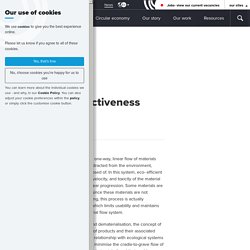
In this system, eco- efficient techniques seek only to minimise the volume, velocity, and toxicity of the material flow system, but are incapable of altering its linear progression.
Learning journey - circular design - Google Slides. UnSchool. Explaining the Circular Economy and How Society Can Re-think Progress. Home - Base Impacts® - Home. Ecodesign Guide - Ecodesign research and implementation at DTU.
DTU Management Engineering, IPU, the Danish Environmental Protection Agency and the Confederation of Danish Industry have developed a practical Guide to integration of environmental thinking into product development.
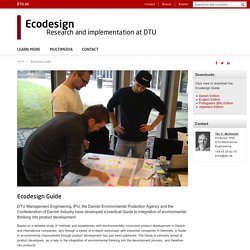
Based on a detailed study of methods and experiences with environmentally conscious product development in Danish and international companies, and through a series of in-depth workshops with industrial companies in Denmark, a Guide to environmental improvement through product development has just been published. The Guide is primarily aimed at product developers, as a help to the integration of environmental thinking into the development process, and therefore into products. It can be said of the majority of companies, that have had environmental issues on the agenda for some years, that the more environmentally analytical, documentation and reporting tasks are now routinely tackled in the organisation. Downloads: Teaching material and posters.
EcoConception & perspective du Cycle de Vie. Actu Environnement : actualité, news, newsletter environnement et développement durable. Recherche_materiaux. Étapes d'une ACV - Étapes d'une ACV - Applications à une cafetière standard. PILOT. MÉTHODOLOGIE DE l'ANALYSE DU CYCLE DE VIE (ACV) - Objectifs. Ce chapitre est destiné à la présentation de la méthodologie d'Analyse du Cycle de Vie et à celle des diverses considérations devant être prises en compte lors de la réalisation d'une telle étude.
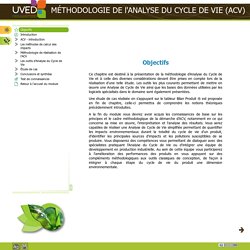
Les outils les plus courants permettant de mettre en œuvre une Analyse de Cycle de Vie ainsi que les bases des données utilisées par les logiciels spécialisés dans le domaine sont également présentées.
Design - Phase - Close The Loop. Digging through the discards of other people’s closets, we seldom find clothes that are completely worn out -- rather, we usually come across pieces that are still perfectly usable.
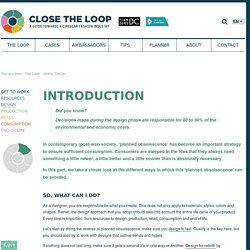
We could argue that products have two potential expiry dates: the first when they break or fall apart, the second when their owner is simply tired of them. This brings us to the question: how can we integrate emotional aspects into our products to make sure our feelings for them last? What could stimulate users to hold on to things a little longer and to temper the need for new? The value of a product is often said to lie mainly in the momentary satisfaction we get from buying it.
Yet after the purchase, these positive feelings tend to fade quickly. Yet by adding the right extra’s, the customer’s positive feelings can be extended, so he will enjoy his product for a longer time. Though at first sight this may seem like playing tricks on the customer, this development often happens bottom-up.
The Loop - Close The Loop. Catalogue - métaux ferreux - OVAM Ecolizer.
ARBOBLEND® ARBOFILL® ARBOFORM®
So that it is easier for you to find your way around when selecting materials, the TECNARO portfolio with more than 3,500 formulas has been divided into three material groups: ARBOBLEND® combines a great number of material types and a wide range of property profiles.
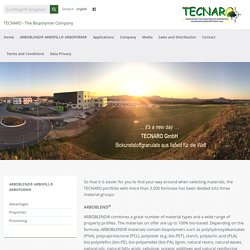
The materials on offer are up to 100% bio-based. Depending on the formula, ARBOBLEND® materials contain biopolymers such as polyhydroxyalkanoates (PHA), polycaprolactone (PCL), polyester (e.g. bio-PET), starch, polylactic acid (PLA), bio-polyolefins (bio-PE), bio-polyamides (bio-PA), lignin, natural resins, natural waxes, natural oils, natural fatty acids, cellulose, organic additives and natural reinforcing fibres. ARBOBLEND® materials are designed to be biodegradable or resistant depending on the intended application.
Biodegradability is a property that offers an additional benefit in applications such as urns, plant aids, mulch films and many other uses.
Fabrication et production de compounds bioplastiques - NaturePlast. NaturePlast produit et commercialise une gamme de compounds de plastiques renouvelables répondant à un certain nombre de problématiques non résolues par les plastiques biosourcés ou biodégradables et compostables bruts.
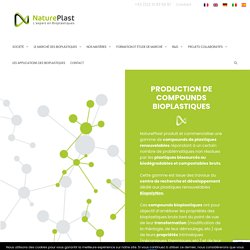
Cette gamme est issue des travaux du centre de recherche et développement dédié aux plastiques renouvelables BiopolyNov.
TECNARO – The Biopolymer Company. Fabrication et production de compounds bioplastiques - NaturePlast. Biolastics. Projet pour une nouvelle résine biosourcée. Create a new adhesive resin free from SVHC compounds which has less impact on human health and the environment,Develop an industrial-scale fermentation process for this molecule of interest more cheaply than its oil-based equivalent,Promote this new adhesive resin technology in the automotive and construction markets (in particular timber),Produce this resin in small, compact and decentralized installations as close as possible to the final customers, reducing its complexity and implementation costs.
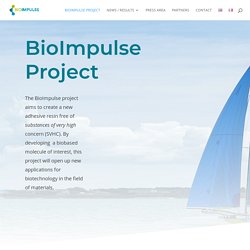
The originality of this project is that it integrates a considerable portion of the value chain: from the biological production of the molecule right through to the application of the resin. Eco-design (including production by fermentation, with the possibility of 2G biomass supply[1]) will be key to the project for health, environmental and economic reasons. [1]Not in competition with the power supply. Rilsan® Polyamide 11 Resins. Produits bio-sourcés – Arkema.com. – BIORESIN, l'alternative de raison. Sustainability Consulting. Eclairage. Économie circulaire. Une complémentarité indispensable et de nouveaux défis !
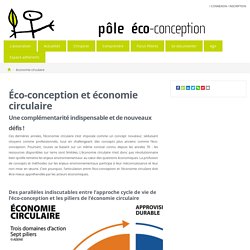
Ces dernières années, l’économie circulaire s’est imposée comme un concept novateur, séduisant citoyens comme professionnels, tout en challengeant des concepts plus anciens comme l’éco-conception. Pourtant, toutes se basent sur un même constat connu depuis les années 70 : les ressources disponibles sur terre sont limitées.
Accueil - MU : agence d'éco-conception. Polymeris - Pôle de competivité des caoutchoucs, plastisques et composites. Page d'Acceuil. The Polyfloss Factory in Madagascar for the project N'Dao Havanao PhD Defense and exhibition at Musée des Arts et Métiers Z33 goes Oblique exhibition curator at Milan Salone del Mobile 2016.
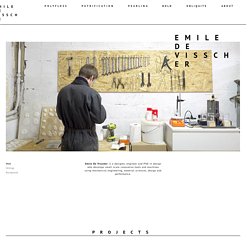
POLYFLOSS. Weden - Innovation. Economiecirculaire.org, la plateforme Internationale de l'économie circulaire. Green Hall Restaurant Icade - Saguez & Partners. Panorama national et pistes d'action sur l'économie de la fonctionnalité. ChangeNOW – International summit for change. Play. "La XXIIeme exposition internationale de la Triennale de Milan "Broken Nature : Design Takes on Human Survival", organisée par Paola Antonelli, se concentre sur "les pratiques créatives dans l'étude des liens de notre espèce avec les systèmes complexes du monde, et la conception de réparations si nécessaire, à travers des objets, des concepts et de nouveaux systèmes". Le PILI expose dans la section française "De la pensée au visible". Design As A Large Ring".
Accueil. Fashion week : comment rendre la mode plus éthique ? Pollution et mode. Difficile de l’ignorer aujourd’hui : la mode est l’une des industries les plus polluantes au monde.
Mais certaines sociétés entendent bien changer la donne. Qu’il s’agisse des pigments utilisés, des fibres non sourcées, ou des modèles de production carrément crados, on peut le dire : le bilan écolo de la mode n’est pas jojo. L’industrie met du temps à changer, les grandes maisons aussi… mais, bonne nouvelle, certaines entreprises choisissent de s’attaquer aux gros problèmes du secteur pour le rendre plus éthique. Petit tour d’horizon. PILI, pour des pigments non polluants. Sustainable Everyday Project. Gunter Pauli : Biomimétisme et économie bleue [EN DIRECT]
Gunter Pauli : « La nature élimine la notion de pauvreté »
« L’économie bleue » promet de régénérer les écosystèmes, de créer une harmonie sociale et une vie d’abondance et s’inspirant de la nature, aux antipodes du modèle économique dominant. Rencontre avec l’auteur Gunter Pauli, qui publie une nouvelle édition de son livre phare L’économie bleue 3.0 (Éditions de l’Observatoire, 2019).
Dans la nature, un écosystème ne produit aucun déchet, ne gâche rien, réutilise tout. Des milliers d’acteurs coopèrent de façon harmonieuse, chacun trouvant de quoi subvenir à ses besoins. La notion de chômage y est inexistante et l’énergie utilisée avec une efficacité qui a de quoi faire pâlir les meilleures technologies humaines. Et le tout en n’utilisant évidemment que des ressources disponibles localement. L’entrepreneur belge, auteur à succès et fondateur du réseau ZERI (Zero Emissions Research and Initiatives) a popularisé ce concept d’économie bleue dans un ouvrage éponyme publié en 2010, issu d’un rapport d’abord rédigé pour le Club de Rome. Oui.
Concept et définition - Quebeccirculaire.org, la plateforme qui rassemble les acteurs de l’économie circulaire au Québec.
Oui ! Plusieurs stratégies de circularité ont fait leur apparition bien avant que l’on parle d’économie circulaire. C'est le cas de l’écologie industrielle, du recyclage et de l’éco-conception par exemple. Appliquées isolément, ces stratégies ne peuvent faire basculer le modèle économique linéaire qui freine fortement leur déploiement.
Innovez en intégrant l'environnement le développement de vos produits par l'éco-conception. Methods. Methods. UP' Magazine. Eco-mobilier. L'éco-conception, c'est quoi ? - Pôle Eco conception. Cliquez pour approfondir Cliquez pour approfondir Cliquez pour approfondir.
Économie circulaire - Pôle Eco conception. BigBang Project - Guillian Graves. Base de données recycleurs - Google Sheets. Toolkit de l'innovation - Google Sheets.










